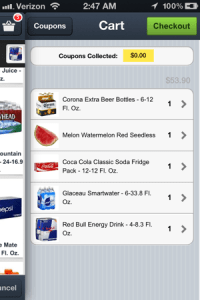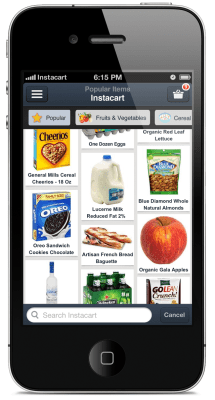When it comes to being the Mall of the Internet, no one really does it better than Amazon. Yet, to truly best its offline competitors and put the icing on the cake in terms of user experience, Amazon has been pushing hard to offer same-day delivery for all items purchased within its virtual walls. However, Amazon CFO Tom Szkutak said last week during the company’s second quarter earnings call that it “doesn’t see a way to do same-day delivery on a broad scale, economically.”
If Amazon hesitates to admit that it’s possible, even as they rush to open new fulfillment centers, it can’t be easy. Of course, in the meantime, one startup wants to pick up Amazon’s slack and offer not just same-day delivery, but one-hour delivery. And naturally, it’s a product of one of their own.
Founded in early June, Instacart is the brainchild of Apoorva Mehta, an ex-Amazon Supply Chain engineer, who is leveraging his experience building Amazon’s own complex backend logistical system in the hopes of creating a more efficient back and front-end grocery delivery experience at Instacart.
So what does that mean for the user? Right now, Instacart is purely a mobile experience and is just available for the iPhone. Plus, as it’s still in the early stages, downloading is invite-only at present. (More on that below.)
While Instacart eventually wants to be Amazon.com with one-hour delivery for anything and everything, the startup is currently focusing on groceries. This means that users can tap-to-order from tens of thousands of items, ranging from produce and booze to deli food, snacks and toiletries. Inventory is sourced from local grocery stores, and Mehta has put together a fleet of trained delivery personnel, who are paid by the hour to pick up the items from local stores and deliver them directly to you — at your home or office.
The service is currently live in San Francisco, Mountain View and Palo Alto and is available between 10am and 9pm. As for the pricing? Users pay a competitive amount for items as they would were they to buy at their local grocery store, plus $9.99 for one-hour delivery and $3.99 for three-hour delivery. Obviously, this is Instacart’s main revenue stream for now, but you can imagine a whole bunch of supplementary revenue streams coming from deals, partnerships with brick and mortar stores, loyalty plans, etc.
 As of right now, Mehta says that Instacart is listing prices based on several factors, including quality of store (especially for produce), proximity of store, and prices. In other words, Instacart is listing items right now based on a combination of factors, but eventually the founder says that he wants users to be able to break down the selection into categories, so that users might be able to choose their shaving cream or toilet paper based on brand, proximity of store (quicker delivery) and price.
As of right now, Mehta says that Instacart is listing prices based on several factors, including quality of store (especially for produce), proximity of store, and prices. In other words, Instacart is listing items right now based on a combination of factors, but eventually the founder says that he wants users to be able to break down the selection into categories, so that users might be able to choose their shaving cream or toilet paper based on brand, proximity of store (quicker delivery) and price.
Users can connect their credit card to the app, browse through listings, and click to add items to their shopping cart. Once users are ready to check out, they select from the startup’s two delivery options and purchase. The items are billed directly to your credit card, and when the delivery arrives, there’s no need to tip. In fact, drivers will not accept tips.
Obviously, Instacart is still in the early phases, so it’s a little too early to say whether this business can truly become Amazon.com with one-hour delivery. But groceries are a great place to start, and provide an easy way for Instacart to test out its model. The startup’s ability to have real impact will start to show as it begins to scale, though I can say from my early experience that, for those busy people living in San Francisco, it already has plenty of value.
In a business like Instacart’s, trust is obviously the big “X factor,” and the founder says that Instacart’s policy for successful orders will be those that are “complete, correct and on time,” so if an order ends up being late or incomplete, Instacart will refund it. Having this policy established from the get-go is important, as customer service will play a big role in successful development.
In the next month, Mehta plans to launch an Android version of Instacart, and bring the service to the web over the next two. As for the present, Instacart is offering free delivery on new users’ first order, and the startup will be making its app available to the first 1,000 readers. You can sign up to receive the app on the Instacart’s homepage here.
